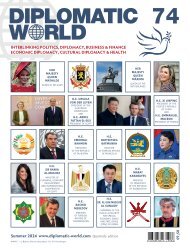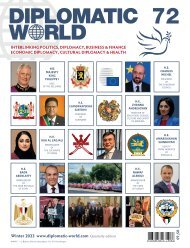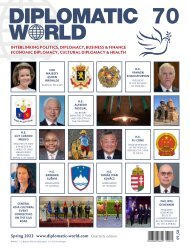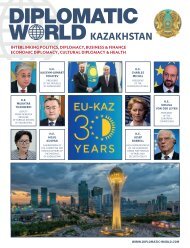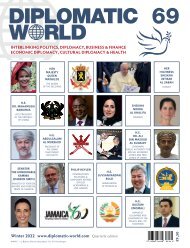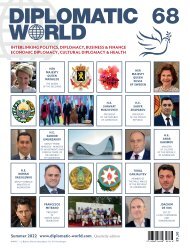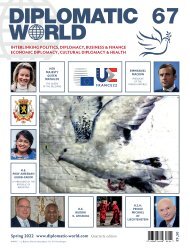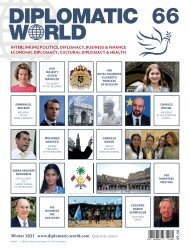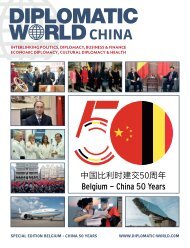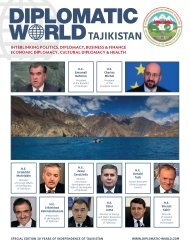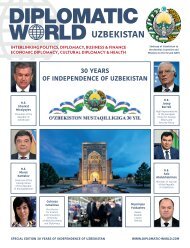Diplomatic World 67
Create successful ePaper yourself
Turn your PDF publications into a flip-book with our unique Google optimized e-Paper software.
at the same time his personal style, but Rubens’s influence is<br />
always present. For history paintings, the young prodigy makes<br />
numerous preparatory drawings or bozzetti, but not for portraits.<br />
In these, he used the support as experimental field, often work-<br />
2* A VERNACULAR ANTWERP VOCABULARY<br />
CONCERNING AUTHENTICITY, LATE XVITH- XVIITH<br />
CENTURY<br />
by the artist, but not always unique or totally by his hand 26 . Some<br />
multiple versions by Veronese or Titian can now be considered<br />
as ‘second originals and possibly with the involvement of the<br />
master’. 27 Such multiple original versions containing multiple<br />
Justin Davis describes: ‘… the absence of any compositional<br />
studies, bozzetti, modelli or head studies’ and ‘It is convincingly<br />
argued that Van Dyck’s thorough and often complex preparatory<br />
thoughts and ideas were worked out on paper and on canvas’ in<br />
ing out several versions in parallel 6 . This is rarer in his early his-<br />
Issues of originality and authorship in paintings had become<br />
hands complicate the statute of the ‘principael’; even if they<br />
Van Dyck’s first period 36 . Angel Veregara shares this opinion 37 .<br />
tory paintings, but well documented for the many versions of the<br />
legal concerns for Antwerp dealers, collectors, and artists.<br />
maintain a close affiliation to the master’s perceived authorship 28 .<br />
‘Martyr of Saint Sebastian’, worked out with a different degree<br />
The Flemish poet, writer, and painter Lucas de Heere (Ghent<br />
It illustrates a sense of responsibility and a guarantee of quality in<br />
In Rubens’s studio, where the young Van Dyck was active 1617-<br />
of studio assistance for each.<br />
1534-1584) was a pupil of Frans Floris I 17 . In an ‘Ode’ c. 1559, he<br />
a legal and qualitative sense, but not necessarily the sole involve-<br />
1620, different hands were involved in portraiture, resulting in<br />
coined the neologism ‘kopie’ 18 , derived from the French ‘copie’<br />
ment of the master.<br />
different levels of ‘handelinghe’ on the same painting, as a con-<br />
There is a relative consistency in 12 early reference works 7 on<br />
to indicate Michiel Coxcie’s replica of Hubert and Jan van Eyck’s<br />
temporary, Dr Otto Sperling, observed in 1621 38 .<br />
plain-woven linen, establishing idiosyncratic modus for Van<br />
Altarpiece, commissioned by King Philips II of Spain.<br />
Even if in the contract between Rubens and Maria de Medici<br />
Dijck’s first period 1613-21 8 . They represent a sample of high-<br />
concerning the paintings for two Luxembourg galleries it was<br />
This is the case c. 1617/18 in the two ‘Portraits of Jean Charles<br />
quality works, even taking in account the negligent autograph<br />
The growth of large-scale art production for the open market was<br />
written that Rubens had to execute everything by his own hand,<br />
de Cordes (inv.2618) and of his Wife Jacqueline van Caestre’<br />
parts in their ductus.<br />
boosted by artist workshops relying on pupils and professional<br />
it was understood that he did not work alone, but assisted by his<br />
(inv. 2619), panel each 72,2 x 57 cm, in the Brussels Museum 39 ,<br />
assistants. This shift in artistic practice and the widening conno-<br />
studio in the usual way 29 . Arnout Balis observes that this fact is<br />
now sometimes attributed to ‘Rubens and his Studio and Van<br />
These differ often only slightly from the weakness in ductus,<br />
tations of the terms ‘originaal’ and ‘kopie’ gave way to lawsuits.<br />
accepted in the Rubens and Jordaens literature but silenced in<br />
Dijck’, as Balis and Van der Auwera think, or following Hélène<br />
indicating assistant’s work 9 . Replicas are of such a high quality<br />
October 3, 1575, the city council of Antwerp passed legislation<br />
the recent Van Dyck publications, even if Roose, Bode, Rosen-<br />
Dubois and Nora De Poorter by the young Van Dyck with studio<br />
that they only become identifiable as such by comparison with<br />
proscribing forgeries, sanctioning them with a fine of ‘drie pon-<br />
baum, Oldenburg and Glück did mentioned it before 30 .<br />
assistance 40 . Both panels share a plank of the same tree 41 . Balis’s<br />
the ‘principael’.<br />
den Brabantsch’ 19 .<br />
opinion is that in the man’s portrait, the head is by Rubens and<br />
‘Naer t’leven’, asserting a stance towards a source, is in Antwerp<br />
the wife’s head by Van Dyck, the rest of both painting’s by at<br />
He innovates technically through his direct demonstrative touch,<br />
The Antwerp city magistrate relied on painters from the Guild of<br />
in the first quarter of the seventeenth century not only a claim to<br />
least two different assistants.<br />
leaving parts of the canvas empty and covering or not in part the<br />
saint Luke as experts in the matter. Gabriele Druet, an art dealer,<br />
objectivity but also to the artist’s creative approach to his model,<br />
earlier layer or preparation. In most cases multiple hands were<br />
questioned, in a court case on January 7, 1576, the authentic-<br />
as we observe in Van Dyck’s ‘Portrait of Cornelis de Vos and his<br />
Joost Van der Auwera and Arnout Balis share this opinion and<br />
also involved in these experiments. See therefore the München<br />
ity of a signed ‘FF. IN. et F.A.’ ‘Cain killing Abel’ presumably by<br />
Family’, since painting as an ’Ars liberalis’ implicates imagination<br />
remarked both independently that the quality of execution of the<br />
Alte Pinakothek head studies c. 1618/20 realized by a least 3<br />
Frans Floris 20 . Frans Pourbus I and Frans Francken I, both former<br />
(uyt den gheest) in Van Dyck’s pictorial strategy (handelinghe) 31 .<br />
man’s cloth is higher than that of the woman’s dress. Two bigger<br />
hands 10 .<br />
Floris pupils, gave an eyewitness testimony.<br />
The young van Dyck started, in the present author’s opinion,<br />
size versions of the same sitters in the Lazienski Palace, belong-<br />
in many cases more than one original to be able to experiment<br />
ing to the Warsaw National Museum (panel 105,5 x 76,2 cm, inv.<br />
The most extensive primary source for Van Dyck’s early career<br />
Frans Francken the Elder admitted he was asked and direct-<br />
thoroughly his ‘handelinghe’ in a sequential approach on more<br />
LKr 840), are recently cleaned. The discussion if they could be<br />
is a trial held from 1660 to 1662 11 . Three of Van Dyck’s former<br />
ed by Floris to paint it ‘doen conterfeiten’, which means as a<br />
than one canvas.<br />
accepted as original is still open.<br />
associates gave testimony regarding the authenticity of a set of<br />
faithful replica considered as an original, and that he has seen<br />
apostle portraits that were attributed to Van Dyck. Jan Breughel<br />
the Younger testified that he had visited Van Dyck in his workshop<br />
in the house the Dom van Ceulen (probably early 1618 until<br />
March 16, 1620).<br />
Floris himself involved in painting it 11 years before, when he<br />
resided with Floris. This reveals a nuanced vocabulary relating<br />
to a replica in which the master was involved. Therefore, it was<br />
considered as an ‘origineel’, it originated directly from the mas-<br />
3* VAN DYCK’S EARLY STUDIO PRACTICE<br />
1617-1620<br />
The difficulty of authentication is also illustrated by the changing<br />
attributions of a portrait of Van Dyck in the Antwerp Rubenshuis,<br />
now by most scholars accepted as by Rubens 42 .<br />
ter’s invention without being totally made by his hand. It was not<br />
It was common practice to start more than one version at one<br />
These examples demonstrate that multiple anonymous hands<br />
Justus van Egmont and Herman Servaes (1598/1601-1<strong>67</strong>4/75)<br />
made to deceive 21 .<br />
time 32 , as we observe in both canvasses c. 1623/25: the ‘Allegory<br />
were implicated in the ‘handelinghe’ of an original portrait in<br />
declared that they had worked as Van Dyck’s assistants there at<br />
of Fruitfulness’ (201,1 x 229,5 cm, Wallace collection London,<br />
Rubens’s studio at that time the young Van Dyck had a super-<br />
the beginning of Van Dyck’s career, contributing themselves to<br />
A ‘weerga’ indicates a faithful reiteration of a painting, of an ob-<br />
inv. P 120) and the ‘Allegory of Fertility’ (180 x 241 cm, MFA<br />
vising function there and when he was allowed there a certain<br />
these original Van Dyck paintings 12 . Scholars dispute the exact<br />
ject, or of a person’s physiognomy, as in a portrait ‘naer t’leven’,<br />
Brussels inv. 119) by Jacques Jordaens. Under the Wallace<br />
degree of economic and creative freedom.<br />
dates for the Dom van Ceulen workshop and the extent to which<br />
a ‘nabeeld’ or ‘afbeeld’. This indicates a sequential relationship<br />
collection painting, an earlier complete version of the Brussels<br />
it was an independent studio or merely a flexible outgrowth of<br />
with a model, in nature or in art. It does not implicate a difference<br />
painting was discovered by X-ray examination. The artist re-<br />
Technical analysis of different versions can shed some light in<br />
Rubens’s atelier.<br />
in quality of execution as there is in the production of unnamed<br />
worked many times the ‘principael’ in the Wallace collection<br />
this matter of complicated connoisseurship concerning Rubens,<br />
studio assistants. Floris’s workshop may have had 120 assistants<br />
London 33 , upgrading it over time at the evolution of style, and this<br />
van Dyck and Jordaens, in which my longstanding friend Arnout<br />
Justus van Egmont (1601-1<strong>67</strong>4) 13 was recorded shortly after<br />
over the years, trained to work ‘naer’(after) the master 23 .<br />
over some decades.<br />
Balis was the ‘primus inter pares’.<br />
1618 as an assistant to Van Dyck, as well as to Rubens. He<br />
made also copies retouched by van Dyck. In 1617/18 Van Dyck<br />
The verbal taxonomy was precise. Karel van Mander referred<br />
Therefore, as Van der Auwera writes: ‘The current periodization<br />
accommodated on Rubens’s property.<br />
to van Eyck’s original as ‘de principaele tafel’ and to Coxcie’s<br />
of his oeuvre and the dating of several works need more nuance<br />
copie as ‘dese geconterfeyte tafel 24 ’. The ‘principael’ (primacy)<br />
and adjustment’ 34 . The ’principael’ remained in the studio as an<br />
Rubens names someone ‘il meglio mio discepolo’ 14 , we suppose<br />
represented the first and best artistic expression of a the several<br />
asset to be copied. Other original versions were initiated simul-<br />
he refers to Van Dyck, but this is not certain. He assists Rubens<br />
iterations of a composition by the master in a large hierarchical<br />
taneously, as we see in Jan Breughel the Younger’s workshop<br />
on the Decius Mus tapestry series and on the ceilings of the<br />
workshop. Assistants were often tasked to copy it, sometimes<br />
register 35 . This was also the case in Rubens, Van Dyck and other<br />
Jesuit church 15 . Rubens often directs clients for portraits to Van<br />
with a certain limited degree of creativity, under (or not) the<br />
Antwerp studios.<br />
Dyck and Cornelis de Vos 16 .<br />
supervision of the master 25 . It was generally regarded as painted<br />
110 111




